

e-mail :

This document continues the investigation of special categories (If / Then constants), and compares crystals with organisms.
Crystals and Organisms, Shape, Symmetry and Promorph.
Sequel to the investigation of some (intrinsic) shapes of two-dimensional crystals regarding their relationship to intrinsic point symmetry and promorph.
Regular Gyroid Ditrigon
We will now investigate two-dimensional crystals with an intrinsic shape according to a regular gyroid ditrigon as to their possible promorphs, but, as in the foregoing, limiting ourselves to holomorphic crystals, which means that we will only investigate crystals of which their intrinsic symmetry is the same as the symmetry of their intrinsic shape. In the present case this means that our regular gyroid ditrigonal crystals will have C3 intrinsic symmetry (while in other cases -- meromorphic crystals -- this symmetry could be according to C1 (the Asymmetric Group), depending on the crystal's internal structure). The periodically stacked building blocks of crystals with intrinsic symmetry according to the group C3 (as well as C6 , D3 and D6 ) must be 60/1200 rhombi, forming a hexagonal net. The next Figure depicts this net.
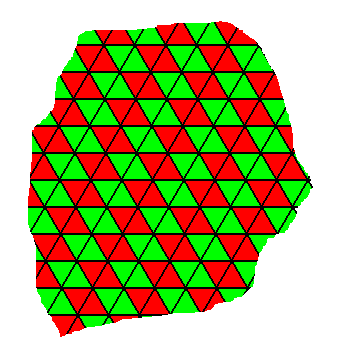
Figure above : Hexagonal net consisting of identical equilateral triangles, non-periodically repeated. But every two such triangles, base to base, form a 60/1200 rhombic building block (red, green) that generates the hexagonal net (lattice) by its being periodically stacked. Because the triangles are equilateral we can rephrase "base to base" as "side to side".
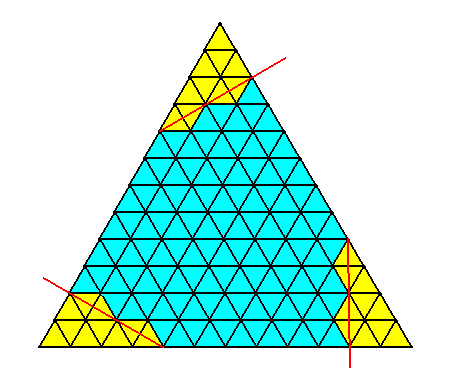
Figure above : Construction of a two-dimensional C3 crystal with intrinsic shape according to a regular gyroid ditrigon, from a regular trigon (equilateral triangle) built up by the periodic stacking of 60/1200 rhombic building blocks.
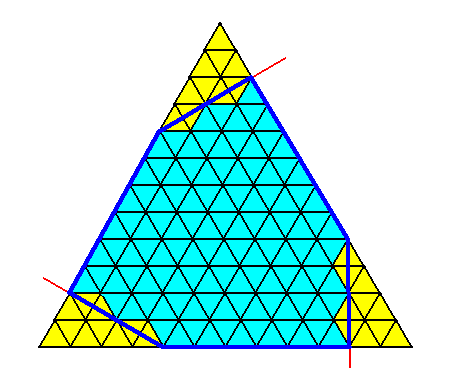
Figure above : The emerging outline ('faces', dark blue lines) of the two-dimensional C3 crystal with intrinsic shape according a regular gyroid ditrigon, under construction from a regular trigon built up by the periodic stacking of 60/1200 rhombic building blocks.
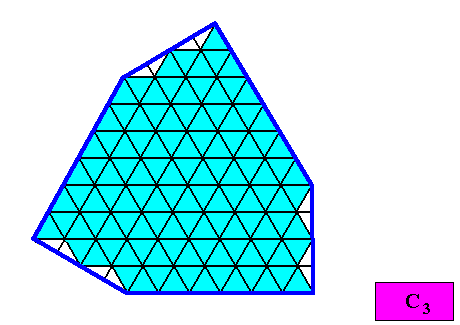
Figure above : The resulting two-dimensional C3 crystal with intrinsic shape according a regular gyroid ditrigon.
Removing all auxiliary line segments in the blank areas (representing incomplete building blocks) gives :
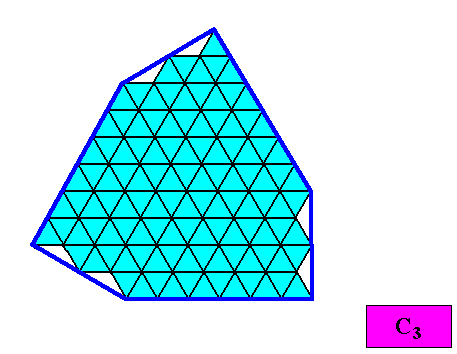
Figure above : The resulting two-dimensional C3 crystal with intrinsic shape according a regular gyroid ditrigon.
What we have here (Figure above) is a microscopic view of the crystal. It is supposed to be built up by the periodic stacking of (60/1200) r h o m b i c building blocks, as its ultimate periodic constituents. And indeed, if the crystal should be totally periodic, then only whole building blocks are allowed, because the presence of an incomplete building block (i.e. adding an incomplete building block) is not a repetition. The next Figures satisfy this demand.
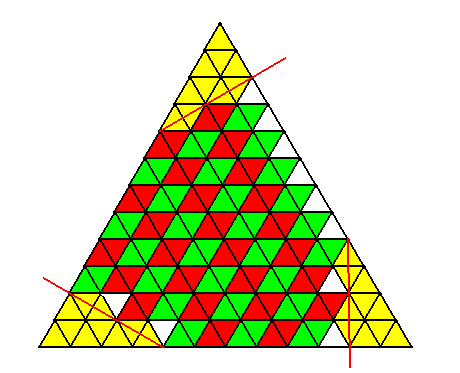
Figure above : The two-dimensional C3 crystal with intrinsic shape according a regular gyroid ditrigon. It is drawn such that only whole (rhombic) building blocks (marked red, or green) are going to participate in the formation of the crystal. Incomplete building blocks (white) -- half building blocks (equilateral triangles) in this case -- have therefore been erased from the drawing. See also next two Figures, completing the construction.
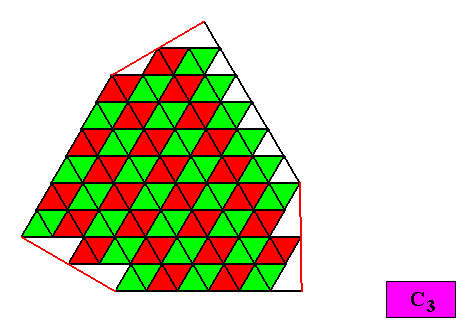
Figure above : The two-dimensional C3 crystal with intrinsic shape according a regular gyroid ditrigon. It is drawn such that only whole (rhombic) building blocks participate in the formation of the crystal. Faces are indicated by lines (which together form a regular gyroid ditrigon).
Without the indication of the faces the microscopic view of the crystal looks as follows :
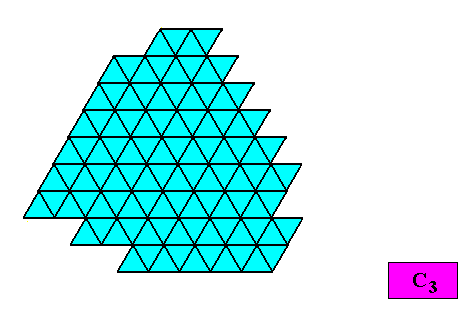
Figure above : The two-dimensional C3 crystal with intrinsic shape according a regular gyroid ditrigon. It is drawn such that only whole (rhombic) building blocks participate in the formation of the crystal.
The rhombi of the hexagonal net consist of two (equilateral) triangles, connected base to base (side to side). In the previous Figures, a triangle was taken, and then another (side to side) adjacent triangle was added to constitute a rhombus. And this rhombus was considered to be periodically repeated resulting in the hexagonal net.
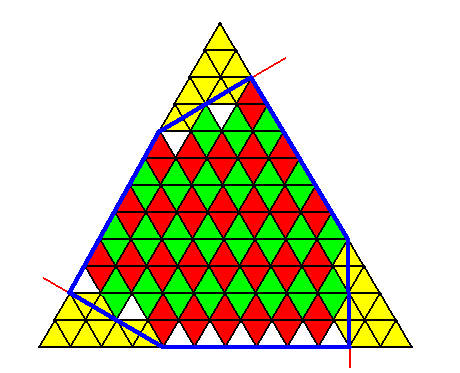
Figure above : Construction of the above two-dimensional C3 crystal with intrinsic shape according a regular gyroid ditrigon. Rhombi as composed of two (side to side) adjacent triangles, differently conceived in virtue of an alternative choice of the second triangle, forming a rhombus with a first triangle, as explained just above. Compare with the original choice of adjacent triangle, as was done above .
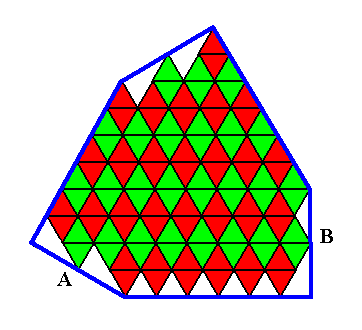
Figure above : Result of the construction, as begun in the previous Figure. The effect of the alternative choice of the second triangle to form a rhombus, is the same as that obtained by a (clockwise) rotation of the original figure by 1200 about its center. Compare with the corresponding result obtained earlier .
The determination of the direction of the faces marked A and B, as two of the possible faces sustained by the hexagonal net, is shown in the next two Figures.
The determination of the direction of the face A as indicated in the previous Figure, as one of the possible faces allowed and sustained by the hexagonal net, is shown in the next Figure.
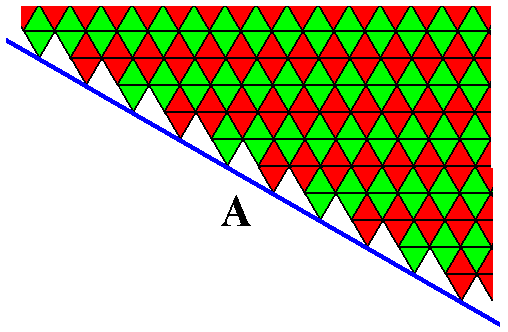
Figure above : The face A as indicated in the previous Figure, as one of the possible faces allowed and sustained by the hexagonal net.
The determination of the direction of the face B as indicated in that same Figure, as one of the possible faces allowed and sustained by the hexagonal net, is shown in the next Figure.
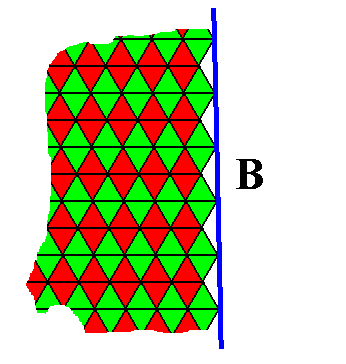
Figure above : The face B as indicated in the Figure referred to earlier, as one of the possible faces allowed and sustained by the hexagonal net.
Although the last seven Figures depict the constitution of the crystal fully correctly by allowing only whole (complete) rhombic building blocks to participate in the crystal's formation, these, and also all other Figures depicting the internal crystal structure, depict only a few building blocks. In reality however, even a very small crystal is built up by a huge number of such building blocks. And because of this huge number the crystal's outline, in our case the regular gyroid ditrigonal outline, is much more clearly expressed. So to accommodate for this we will stick to the drawings made earlier in this document, where also half rhombi (such that these halves are equilateral triangles) are admitted to participate in the crystal's formation, resulting in its shape being more clearly expressed. Moreover, as one can see, the (three by three) equivalence of the corresponding faces of the crystal is particularly evident in these earlier Figures.
The next Figure shows a macroscopic view of our regular gyroid ditrigonal two-dimensional crystal.
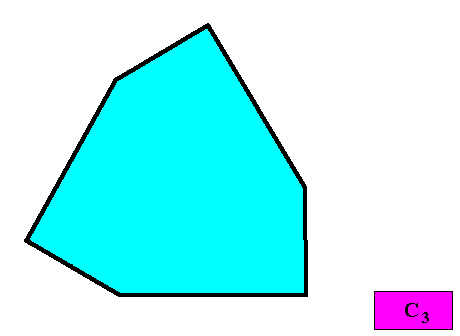
Figure above : Macroscopic view of the two-dimensional C3 crystal with intrinsic shape according a regular gyroid ditrigon, obtained by the removal of all lattice connection lines (i.e. including the lines that divide the rhombi into equilateral triangles, lines, which are also (point) lattice connection lines).
The next Figure shows the pattern of symmetry elements of our crystal.
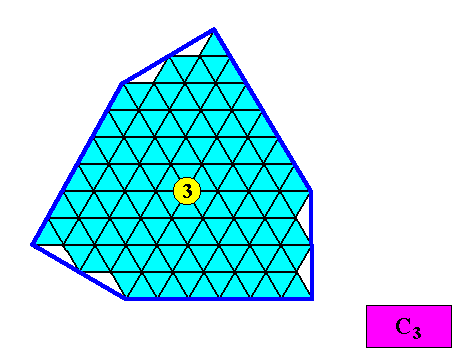
Figure above : Pattern of symmetry elements of the two-dimensional C3 crystal with intrinsic shape according a regular gyroid ditrigon. It consists of one 3-fold rotation axis only, passing through its center (See also next Figure).
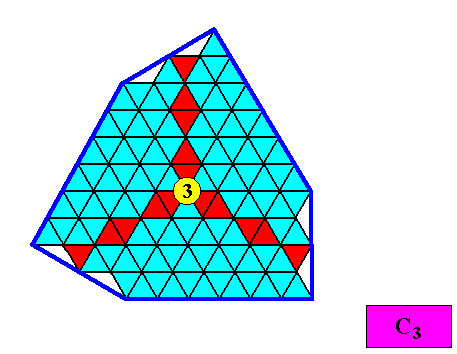
Figure above : Clarification of the 3-fold rotation axis of the crystal under investigation.
Two (crystallographic) Forms are needed to construct our two-dimensional C3 regular gyroid ditrigonal crystal :
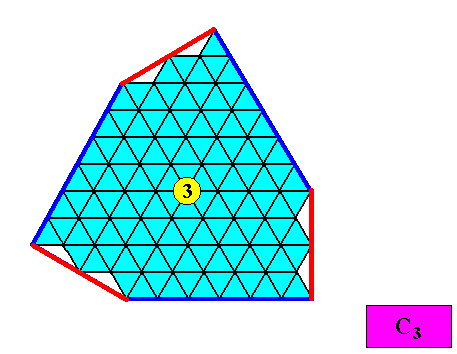
Figure above : Two crystallographic Forms are needed to construct the faces (and with them the outline) of our C3 regular gyroid ditrigonal crystal : An initially given face (red) implies two more faces in virtue of the 3-fold rotation axis. The result is a closed Form consisting of three faces (equilateral triangle). A second initially given face (dark blue), not parallel to one of the faces of the first Form, also implies two other faces in virtue of that same 3-fold rotation axis, also resulting in a closed Form (equilateral triangle). The two Forms combine to give our regular gyroid ditrigonal crystal.
Our crystal is supposed to have an intrinsic shape according to a regular gyroid ditrigon. The symmetry of this shape is according to the group C3 . And because we only consider holomorphic crystals, the intrinsic symmetry of our crystal must also be according to that group. This must now be expressed by appropriate motifs. These motifs, as we will draw them, represent the translation-free residue of the crystal. The symmetry of this residue is in all cases of holomorphic regular gyroid ditrigonal crystals according to the group C3 , while further details of its morphology determine the number of its antimers. And this is then at the same time the number of antimers of the crystal. The intrinsic C3 symmetry allows for either three equal antimers to be present, or a multiple of three antimers, which are then similar (three by three equal).
Possible a n t i m e r c o n f i g u r a t i o n s for holomorphic regular gyroid ditrigonal two-dimensional crystals.
Three antimers.
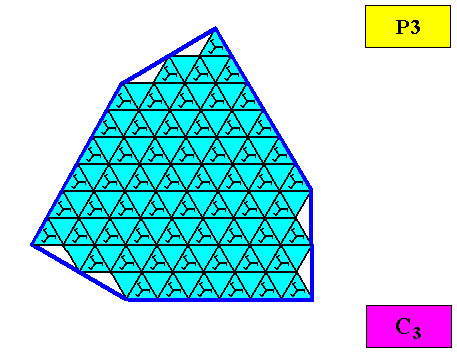
Figure above : The empty rhombic building blocks of our regular gyroid ditrigonal crystal have been explicitly provided with C3 motifs : Each rhombic building block receives one C3 motif in the center of its lower half, or, in other words : In the center of each lower equilateral triangle (which is half a rhombic building block) a C3 motif has been placed. The plane group to which our crystal belongs is now P3. See also next Figure.
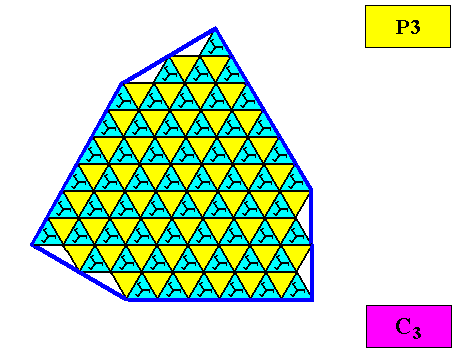
Figure above : Same as previous Figure. The distribution of the C3 motifs is clarified.
And when the lattice connection lines (which as such do not belong to the crystal) are removed :
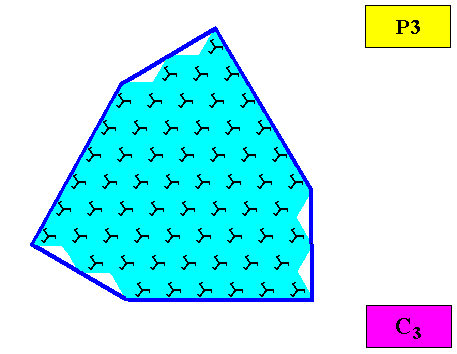
Figure above : Same as previous Figures. Lattice connection lines removed.
The next Figure highlights the three-fold rotation axis of our C3 regular gyroid ditrigonal two-dimensional crystal.
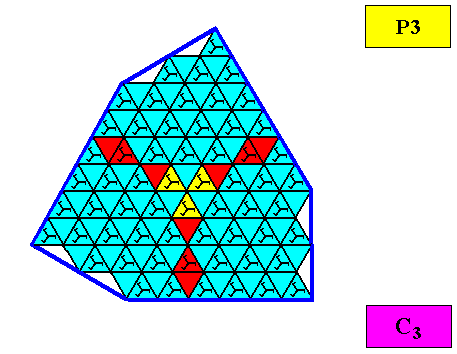
Figure above : The 3-fold rotation axis of the crystal under investigation (as its only symmetry element) is highlighted.
The next Figure shows the three equal antimers as macroscopically expressed.
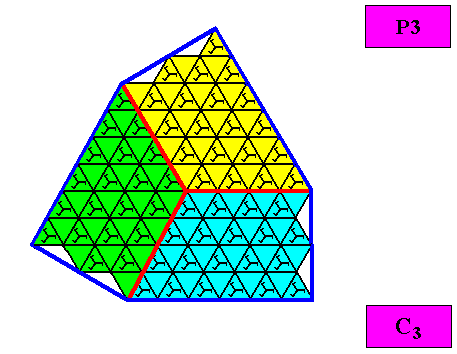
Figure above : The regular gyroid ditrigonal C3 two-dimensional crystal of the previous Figures. The case of t h r e e equal (and in themselves asymmetric) antimers (green, yellow, blue). Note the correspondence between the morphology of the (microscopic) motif (as translation-free residue) and the arrangement of the (macroscopic) antimers of the crystal. In this way the promorph, and in particular the number of antimers is based on the morphology of the translation-free residue of the crystal. This residue is explicitly given in the form of a C3 motif (black) inside each rhombic building block. It is -- or represents -- an atomic configuration such that three equal, and in themselves asymmetric, antimers, relating to each other by a 3-fold rotation axis, can be distinguished in it. The crystal is non-eupromorphic because its intrinsic shape suggests six similar antimers, while only three (equal) antimers are present.
Removing the lattice connection lines and the motifs in the above Figure, results in a macroscopic view of the crystal :
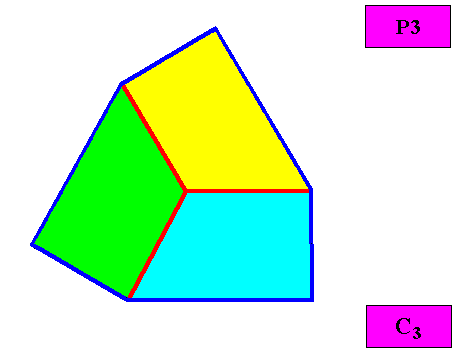
Figure above : Macroscopic view of the regular gyroid ditrigonal C3 two-dimensional crystal of the previous figure, with three equal (and in themselves asymmetric) antimers (green, yellow, blue).
The promorph of the above non-eupromorphic crystal is (as two-dimensional analogue) belonging to the Homogyrostaura trimera. This promorph is depicted in the next Figure.
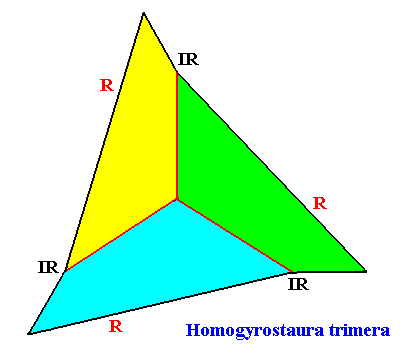
Figure above : The promorph of the regular gyroid ditrigonal C3 crystal with three equal antimers. It is a regular gyroid three-fold polygon with three antimers, and as such the two-dimensional analogue of the regular gyroid three-fold pyramid, which represents the promorph of corresponding three-dimensional crystals or other objects. Note the similar shapes of the promorph (regular gyroid three-fold polygon) and the crystal (regular gyroid ditrigon). In fact the above drawing of the crystal could be used to represent this promorph. In the present drawing, however, the gyroid nature is more conspicuously displayed. Radial (R) and interradial (IR) directions are indicated.
Six antimers.
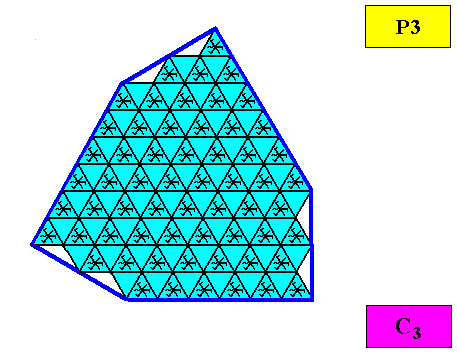
Figure above : Microscopic view of a regular gyroid ditrigonal C3 crystal. Its C3 motifs have six similar antimers (three by three equal). Two types of antimer alternate with each other.
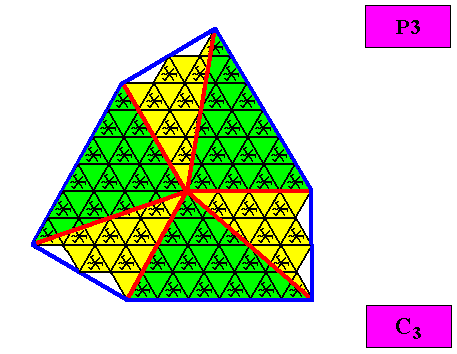
Figure above : The regular gyroid ditrigonal C3 two-dimensional crystal of the previous Figure. The case of s i x similar (and in themselves asymmetric) antimers (green, yellow). Note the correspondence between the morphology of the (microscopic) motif (as translation-free residue) and the arrangement of the (macroscopic) antimers of the crystal. In this way the promorph, and in particular the number of antimers is based on the morphology of the translation-free residue of the crystal. This residue is explicitly given in the form of a C3 motif (black) inside each rhombic building block. It is -- or represents -- an atomic configuration such that six similar (and three by three equal), and in themselves asymmetric, antimers, relating to each other by a 3-fold rotation axis), can be distinguished in it. The crystal is eupromorphic because its intrinsic shape suggests six similar (and in themselves asymmetric) antimers, which are indeed present.
Removing the lattice connection lines and the motifs in the above Figure, results in a macroscopic view of the crystal :
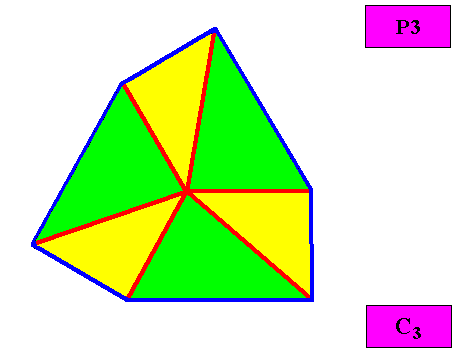
Figure above : Macroscopic view of the regular gyroid ditrigonal C3 two-dimensional crystal of the previous Figure, with six similar (and in themselves asymmetric) antimers (green, yellow).
The promorph of the above eupromorphic crystal is (as two-dimensional analogue) belonging to the Homogyrostaura ditrimera. This promorph is depicted in the next Figure.
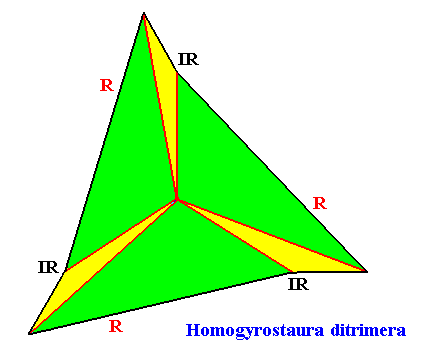
Figure above : The promorph of the regular gyroid ditrigonal C3 crystal with six similar antimers. It is a regular gyroid three-fold polygon with six similar antimers and as such the two-dimensional analogue of the regular gyroid three-fold pyramid, which represents the promorph of corresponding three-dimensional crystals or other objects. Note the similar shapes of the promorph (regular gyroid 3-fold polygon) and the crystal (regular gyroid ditrigon). In fact the drawing of the crystal itself already expresses the promorph well. Nevertheless we have chosen the present Figure to represent this promorph, because it clearly expresses its gyroid nature. Radial (R) and interradial (IR) directions are indicated.
In the next document we will discuss the thirteenth and final crystal shape of our list (as given in Part XVI ) , viz. the regular gyroid dihexagon, with respect to intrinsic symmetry and promorph in holomorphic two-dimensional crystals having this shape intrinsically.
e-mail : 
To continue click HERE for further study of the Theory of Layers, Part XXVIII.